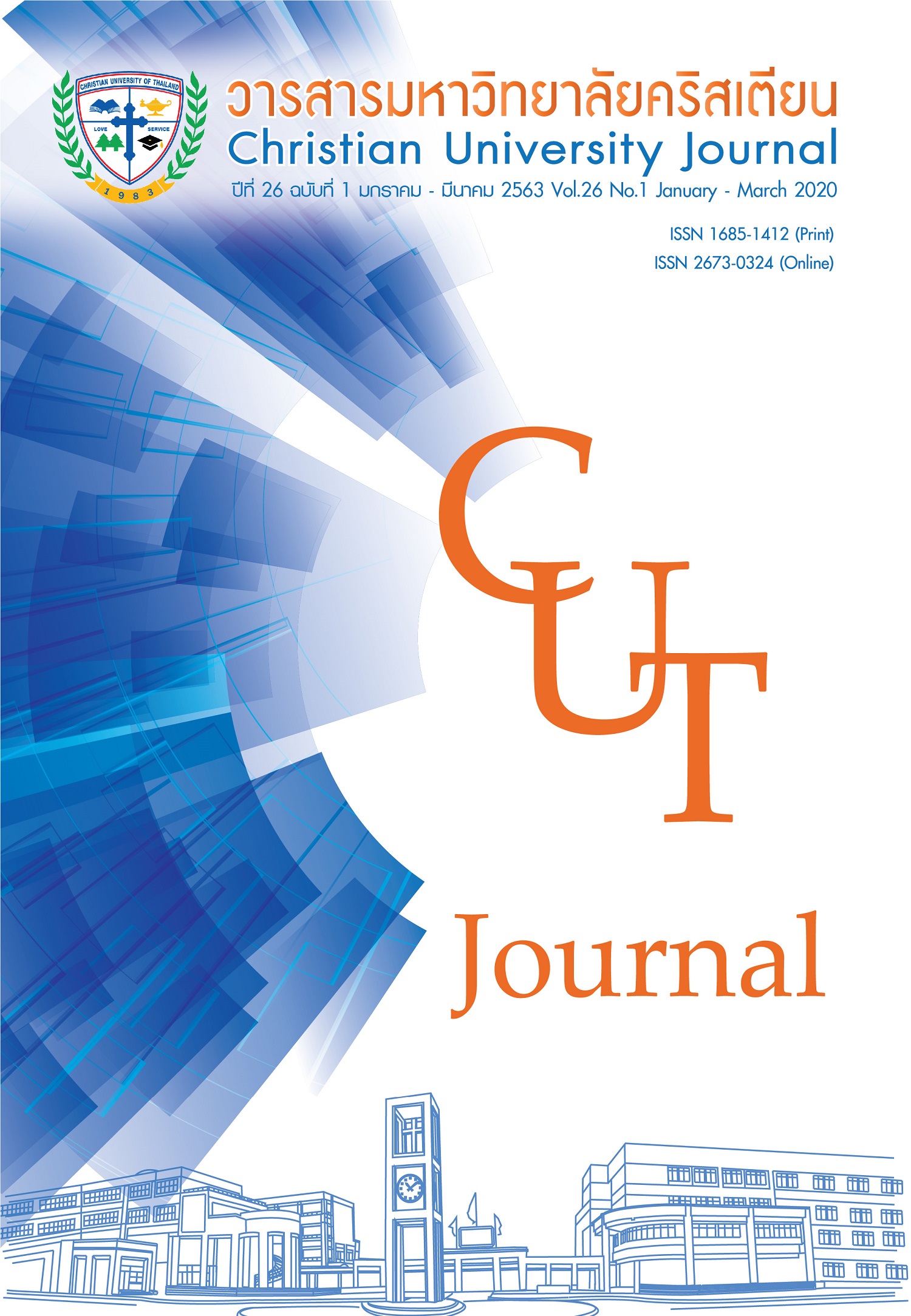โมเดลความสัมพันธ์เชิงสาเหตุระหว่างการจัดการเชิงกลยุทธ์ การจัดการเทคโนโลยีดิจิทัล กับความได้เปรียบในการแข่งขันอย่างยั่งยืนของสถาบันอุดมศึกษาเอกชนในประเทศไทย
คำสำคัญ:
การจัดการเชิงกลยุทธ์, การจัดการเทคโนโลยีดิจิทัล, ความได้เปรียบในการแข่งขันอย่างยั่งยืน, สถาบันอุดมศึกษาเอกชนในประเทศไทยบทคัดย่อ
การวิจัยครั้งนี้มีวัตถุประสงค์ เพื่อวิเคราะห์โมเดลความสัมพันธ์เชิงสาเหตุของการจัดการเชิงกลยุทธ์ การจัดการเทคโนโลยีดิจิทัลกับความได้เปรียบในการแข่งขันอย่างยั่งยืน กลุ่มตัวอย่างได้แก่ผู้บริหารระดับต่างๆ ของสถาบันอุดมศึกษาเอกชนในประเทศไทยที่เป็นสมาชิกสมาคมสถาบันการศึกษาเอกชน 68 แห่ง จำนวน 260 คน เครื่องมือที่ใช้ในการวิจัยครั้งนี้เป็นแบบสอบถามเกี่ยวกับการจัดการเชิงกลยุทธ์ การจัดการเทคโนโลยีดิจิทัลและความได้เปรียบในการแข่งขันอย่างยั่งยืนของสถาบันอุดมศึกษาเอกชนในประเทศไทย เป็นแบบมาตราส่วนประมาณค่า 5 ระดับ ค่าความเชื่อมั่นของแบบสอบถาม เท่ากับ 0.964 0.958 และ 0.947 ตามลำดับ
ผลการวิเคราะห์โมเดลสมการเชิงโครงสร้าง พบว่า การจัดการเชิงกลยุทธ์มีอิทธิพลโดยตรงต่อการจัดการเทคโนโลยีดิจิทัลอย่างมีนัยสำคัญทางสถิติที่ระดับ .05 โดยมีค่าสัมประสิทธิ์เส้นทางเท่ากับ .86 การจัดการเทคโนโลยีดิจิทัลมีอิทธิพลโดยตรงต่อความได้เปรียบในการแข่งขันอย่างยั่งยืนอย่างมีนัยสำคัญทางสถิติที่ระดับ .05 โดยมีค่าสัมประสิทธิ์เส้นทางเท่ากับ .87 การจัดการเชิงกลยุทธ์ไม่มีอิทธิพลโดยตรงต่อความได้เปรียบในการแข่งขันอย่างยั่งยืน การจัดการเชิงกลยุทธ์มีอิทธิพลโดยอ้อมต่อความได้เปรียบในการแข่งขันอย่างยั่งยืนโดยผ่านการจัดการเทคโนโลยีดิจิทัลอย่างมีนัยสำคัญทางสถิติที่ระดับ .05 โดยมีค่าสัมประสิทธิ์เส้นทางเท่ากับ .75 ดังนั้น สถาบันอุดมศึกษาเอกชนจึงควรกำหนดแผนกลยุทธ์เทคโนโลยีดิจิทัลในการบริหารสถาบันทุกๆ ด้านเพื่อความได้เปรียบในการแข่งขันอย่างยั่งยืน
เอกสารอ้างอิง
กิตติพร เนาว์สุวรรณ และ ชัยรัตน์ จุสปาโล. (2557). การเตรียมความพร้อมการจัดการศึกษาด้วยเทคโนโลยีสารสนเทศในสถานศึกษาเพื่อเข้าสู่ประชาคมอาเซียน. วารสารมหาวิทยาลัยนราธิวาส, 6(2). 156-168.
คินิกกี้, แอนเจโล และ วิลเลียมส์, ไบรอัน. (2552). องค์การและการจัดการ. [Management 3/e] (กิ่งกาญจน์ วรนิทัศน์ ธีรศักดิ์ กัญจนพงศ์ บุตรี จารุโรจน์ ศิวะนันท์ ศิวพิทักษ์ โศภชา อรัญวัฒน์ โสภณแย้มกลิ่น และ เบญจมาภรณ์ อิศรเดช ดร. ผู้แปลและเรียบเรียง) กรุงเทพฯ: สำนักพิมพ์แมคกรอ-ฮิล.
พิมพ์เขียว Thailand 4.0. (2560). โมเดลขับเคลื่อนประเทศไทยสู่ความมั่งคั่ง มั่นคง และยั่งยืน. สืบค้น จาก https://www.libarts.up.ac.th/v2/img/Thailand-4.0.pdf
สำนักงานคณะกรรมการอุดมศึกษา. (2561). สถาบันอุดมศึกษาในสังกัด. สืบค้น จาก https://www.mua.go.th/ university.html
สุธนิต เวชโช. (2561). คิดนอกกรอบ: ยุคของข้อมูลขนาดใหญ่ กับโอกาสในการพัฒนาการศึกษาไทย. วารสารครุศาสตร์ จุฬาลงกรณ์มหาวิทยาลัย, 46(3) 416-435.
Barney, J. B., & Clark, D.N. (2007). Resource-Based Theory: Creating and Sustaining Competitive Advantage. New York: Oxford University Press.
Brahimi, T., & Sarirete, A. (2015). Learning outside the classroom through MOOCs. Computers in Human Behavior. 51, 604-609.
British Council. (2014). Global Education Dialogues: The East Asia Series 2013-14. Retrieved from https://www.britishcouncil.jp/sites/default/files/ged_reputation_management_in_higher_education_6th-7th_march_2014_report.pdf
Culado, C. & Bontis, M. (2006). The knowledge-based view of the firm and its theoretical precursor. Int. J. Learning and Intellectual Capital, 3(4) 367-381.
Cultural and Education Section British Embassy. (2013). The impact of digital technology on higher educations. Retrieved from https://www.britishcouncil. org/sites/default/files/ged_17_oct_report.pdf
David, F.R., & David, F.R. (2015). Strategic Management Concepts. (5th Edition). Essex, UK: Pearson Education Limited.
GENÇ, E. & ŞENGÜL, (2015). A Review on the Relationship Between Strategic Management and Performance: The Role of Internal and External Contexts. Strategic Public Management Journal (SPMJ), (2), 56-71. Retrieved from https://dergipark.org.tr/download/article-file/274021.
Garad, Y. M, Salad, A. M, & Bashir, H. M, (2015). The Relationship between strategic management and organizational performance in Mogadishu-Somalia. European Journal of Research and Reflection in Management Sciences (2), 42-51. Retrieved from https://pdfs. semanticscholar.org/4d57/860925618f313535e19c86c615e93918d2a4.pdf
Hitt, M.A., Ireman, R.D., & Hoskisson, R.E. (2014). Strategic Management Concept, (7th Edition.) OH, USA: Thomson Higher Education.
Kirkwood, A. (2014). Teaching and learning with technology in higher education: blended and distance education needs ‘joined-up thinking’ rather than technological determinism. Open Learning: The Journal of Open, Distance and E-Learning, 29(3), 206-221. Retrieved from https://dx.doi.org/10.1080/02680513.2015.1009884.
Kising’u, T.M., Namusonge, G.S., & Mwirigi, F.M. (2016). Role of organizational innovation in sustainable competitive advantage in Universities in Kenya. The International of Social Sciences and Humanities Invention, (6), 2762-2786.
Kolb, A., & Kolb, D. (2005). Learning Styles and Learning Spaces: Enhancing Experiential Learning in Higher Education. Academy Of Management Learning & Education, 4(2), 193-212.
Melton, B., & Burdette, T. (2011). Utility to improve the administration of instructional physical activity programs in higher education. Journal of Physical Education Recreation & Dance, 84(4), 27-32.
Raduan, C.R., Jegak, U., Haslinda, A., & Alimin, I.I (2009). Management, Strategic management theories and the linkage with organization competitive advantage from resourced-based view. European Journal of Social Sciences, (3), 402-417.
Sriwidadi, T., Arief, M., Prabowo, H., & Muqarrabin, A.L. (2016). Sustainable competitive advantage in private higher educations in Indonesia. International Journal of Economics and Management, 10(S1): 33-47.
UNESCO Institute for Statistics. (2017). The Data Revolution in Education. Montreal Canada: UNESCO Institute for Statistics.
Wheelen, T. L., & Hunger, J. D. (2012). Strategic management and business policy (13thedition). Upper Saddle River, NJ: Pearson.



